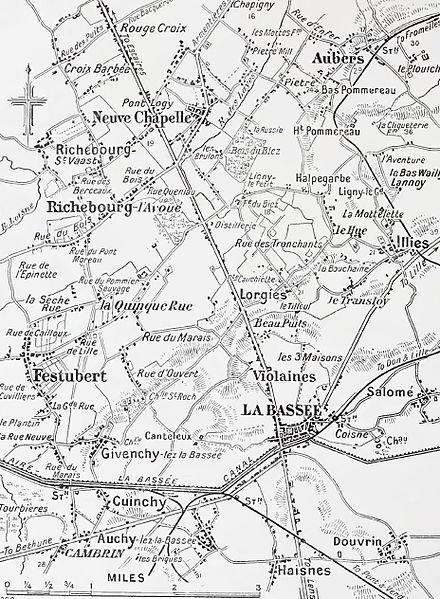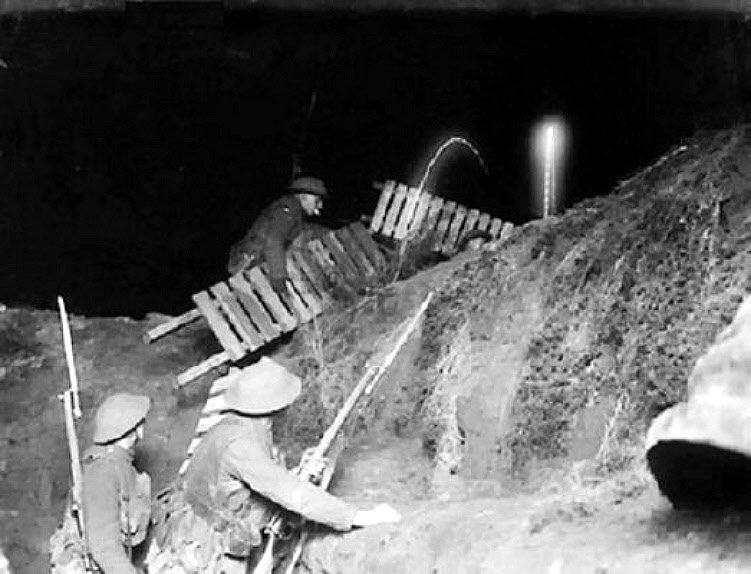
John William Wilby was born in Alverthorpe in 1889, the elder son of Joseph Wilby and his wife Mary Jane (nee Tattersley), who had married in the summer of1872. The couple had nine children from their marriage, but sadly four had died before April 1911. Joseph Wilby was a miner from Whitley and his wife was born in Flockton. All of their children were born in Alverthorpe.
In 1891 and 1901, Joseph and Mary Jane Wilby with their children were all living at 23, Haggs Hill, Ossett. Joseph Wilby was working as a colliery labourer, most probably at the nearby Old Roundwood Colliery. In 1911, the Wilbys were still living in their two-roomed house at Haggs Hill, Ossett with three of their children, including John William, who by now was 21 years of age. Like his father Joseph, John Wilby was a colliery labourer at Old Roundwood Colliery.
John Wilby’s army service record has not survived but it is known that he enlisted at and that he embarked for France on the 11th December 1915, thereby qualifying for the 1914/15 Star, in addition to the British and Victory medals. His medal card also records his earlier service number of 2939.
The 1/4th Battalion, Kings Own Yorkshire Light Infantry was a unit of the Territorial Force with HQ in Wakefield, serving with 3rd West Riding Brigade, West Riding Division. When war broke out in August 1914, the units of the Division had just departed for their annual summer camp at Whitby, and they were at once recalled to their home base and mobilised at once for war service, moving to Doncaster. In November they moved to Gainsborough and in February 1915 to York to prepare for service overseas. Those men who had not volunteered for Imperial Service transferred to the newly formed 2/4th Battalion. They proceeded to France, from Folkestone landing at Boulogne on the 12th of April 1915 and the Division concentrated in the area around Estaires. On the 15th of May the formation was renamed 148th Brigade, 49th (West Riding) Division. Their first action was in the The Battle of Aubers Ridge in May 1915. In 1916 They were in action in the Battles of the Somme. In 1917 they were involved in the Operations on the Flanders Coast and the The Battle of Poelcapelle during the Third Battle of Ypres.
 For much of the war, the 49 (West Riding) Division was involved in static trench warfare, holding parts of the notorious Ypres Salient and, in April 1917, the 1/4th Battalion KOYLI were located at Neuve-Chapelle. In July 1917, they were withdrawn to begin training for an amphibious operation against the German U-boat bases on the Belgian Coast at Nieupoort (Operation Hush.)
For much of the war, the 49 (West Riding) Division was involved in static trench warfare, holding parts of the notorious Ypres Salient and, in April 1917, the 1/4th Battalion KOYLI were located at Neuve-Chapelle. In July 1917, they were withdrawn to begin training for an amphibious operation against the German U-boat bases on the Belgian Coast at Nieupoort (Operation Hush.)
Private John William Wilby was killed in a trench raid that took place on the night of the 10th April 1917:1
On the 10th April 1917, ‘Y’ Company of the 1/4 Bn, KOYLI launched a trench raid on the heavily fortified German trenches near Neuve-Chappelle. The objectives of the raid were to:
The party was under the command of Capt. R.W. Moorhouse and consisted:
The British barrage opened at 10:25pm alerting the Germans that something was happening. They sent up S.O.S. signals all along their line followed at 10:32pm with a strong barrage into ‘No Man’s Land’ with trench mortars and 4.2″ shells, as well as rifle grenades and bombs from the German front line. The British raiders broke through the German barbed wire at one point using Bangalore torpedoes and found the enemy trench full of water and wire with no Germans in the vicinity.
Sadly, the objectives of the raid were not met since the British had failed to check whether the enemy trenches were in use by the Germans prior to attacking. Six men were killed, including Private John William Wilby and thirteen others were wounded, including Captain Moorhouse and 2/Lt. Scholefield.
The “Ossett Observer” 2 had this obituary for John W. Wilby:
“The officer commanding the local company of the King’s Own Yorkshire Light Infantry at the beginning of the week regretfully informed Mr. and Mrs. Joseph Wilby, of 23, Haggs-hill, Ossett, that their son, Private John William Wilby, was instantly killed on the evening of the 10th inst. In conveying the sympathy of the officers and men of the company, the writer said that Private Wilby was a good soldier, one of the most cheerful lads in the battalion, and that his loss would be greatly felt by all his chums out there.
The deceased, who attained his 28th birthday on Easter Sunday, was of a frolicsome disposition, and noted as one of the fun-makers of his company. As a mouth-organ player he was quite an expert and provided no end of amusement and entertainment for his comrades. He joined the army soon after war broke out, and recently visited home on leave from the front. His brother, Arthur, has been at the front about nine months.”

Above: British soldiers taking part in a trench raid during WW1
Private John W. Wilby, aged 28 years, was killed in action on the 10th April 1917 and is buried at grave reference II. A. 9. at the Rue-du-Bacquerot No. 1 Military Cemetery, Laventie, 3 Pas de Calais, France. Aventie is a village in the Department of the Pas-de-Calais, 6 kilometres south-west of Armentieres and 11 kilometres north of La Bassee. Rue-du-Bacquerot No.1 Military Cemetery is 3 kilometres south of Laventie on the north side of the road to La Couture.
The Rue-du-Bacquerot runs south-east of the village, from the Estaires-La Bassee road towards Fleurbaix, and the position of this road close behind the Allied front trenches during the greater part of the First World War made it the natural line of a number of small Commonwealth cemeteries. One of these, begun by the Indian Corps in November 1914, was the nearest to the Estaires-La Bassee road and became known as Rue-du-Bacquerot No.1.
The cemetery was used until May 1917, and for short periods in 1918, by the units holding the line. After the Armistice the small Indian plots were enlarged when graves were brought in from the battlefields and from smaller burials grounds. Nineteen of the Indian graves were brought in from Rue-Des-Chavattes Indian Cemetery, Lacoutre.
The cemetery contains 637 Commonwealth burials and commemorations of the First World War. 61 of the burials are unidentified and special memorials commemorate 12 casualties. The cemetery also contains seven German graves.
References:
1. 1st/4th Battalion, KOYLI War Diary: 1914 – 1919
2. “Ossett Observer”, 21st April 1917